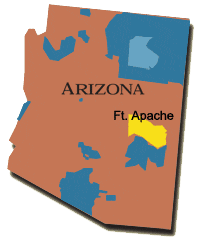| Home | About Us | Services | Success Stories | How to Help | Resources |


Arizona: White Mountain Apache
 |
The White Mountain Apache live on the Fort Apache Reservation. Their economy is based on tourism, forestry, and ranching. About 10,000 Apache Indians live on this reservation.
Today about 10,000 Apache live on the San Carlos Apache Reservation. Forestry, tourism, and agriculture sustain the local economy.
The Tonto Apache once occupied a vast territory that extended from Flagstaff down into Mexico. These Apache were hunters and gatherers who migrated with the seasons. Today, only 100 or so Apache live on the Tonto Apache Reservation, 85 acres halfway between Flagstaff and Phoenix.
Approximately 3,000 Apache live on both the Mescalero and Jicarilla Apache Reservations.
Ancestry
The Apache dominated much of northern Mexico, Arizona, New Mexico, and Texas for hundreds of years. It is estimated that about 5,000 Apache lived in the Southwest in 1680 AD.
Some Apache lived in the mountains, while others lived on the plains. Some hunted big game, while others existed by farming or gathering wild plants.
Their main shelter, a circular brush lodge with a fire at the center, fit their nomadic lifestyle.
The Apache got their name from the Zuni word for "enemy." They often were in conflict with the Pima, Papago, and the Pueblo Indians, as well as the Plains peoples.
Clans, social units based on female inherited leadership, were at the center of the Apache political and economic structure.
The Apache had a series of great leaders: These leaders helped the Apache resist white intrusion into their traditional territories far better than any other group of native people in the Southwest.
"I do not think you will keep the peace. Once again you tell me we can stay in our mountains and our valleys. That is all we wish, we do not want to fight and kill whites, and we do not want the whites to fight and kill us. We want nothing but to live in peace. But I do not believe you will allow us to remain on the lands we love. I warn you, if you try to move us again, war will start once more; it will be a war without end, a war in which every Apache will fight until he is dead. Prove to me that I am wrong; prove to me that this time I can trust you."
Cochise





